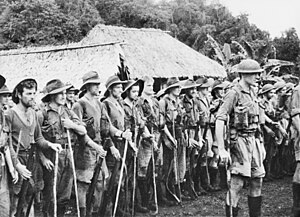Kokoda Campaign
| Kokoda Track campaign | |||||||
|---|---|---|---|---|---|---|---|
| Part of the Pacific War of World War II | |||||||
 Soldiers of the Australian 39th Battalion in September 1942 |
|||||||
|
|||||||
| Belligerents | |||||||
|
|
|
||||||
| Commanders and leaders | |||||||
|
|
|
||||||
| Strength | |||||||
| 30,000 | 13,500 | ||||||
| Casualties and losses | |||||||
| 625 killed 1,055 wounded 4,000+ sick |
~ 2,050 ~ 4,500 including sick. |
||||||
The Kokoda Track campaign or Kokoda Trail campaign was part of the Pacific War of World War II. The campaign consisted of a series of battles fought between July and November 1942 in what was then the Australian Territory of Papua. It was primarily a land battle, between the Japanese South Seas Detachment under Major General Tomitarō Horii and Australian and Papuan land forces. The Japanese objective was to seize Port Moresby by an overland advance from the north coast, following the Kokoda Track over the mountains of the Owen Stanley Range, as part of a strategy to isolate Australia from the United States.
Japanese forces landed and established beachheads near Gona and Buna on 21 July 1942. Opposed by Maroubra Force, then consisting of four platoons of the 39th Battalion and elements of the Papuan Infantry Battalion, they quickly advanced and captured Kokoda and its strategically vital airfield on 29 July. Despite reinforcement, the Australian forces were continually pushed back. The veteran Second Australian Imperial Force (AIF) 21st Brigade narrowly avoided capture in the Battle of Mission Ridge – Brigade Hill from 6 to 8 September. In the Battle of Ioribaiwa from 13 to 16 September, the 25th Brigade under Brigadier Kenneth Eather, fought the Japanese to a halt but ceded the field to the Japanese, withdrawing back to Imita Ridge.
...
Wikipedia
